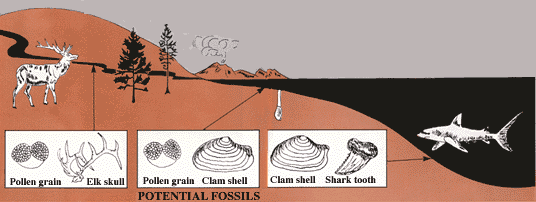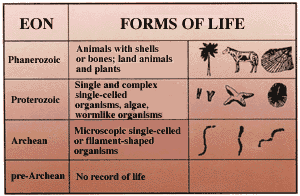ROCKS AND LAYERS
We study Earth's history by
studying the record of past events that is preserved in the rocks. The layers of
the rocks are the pages in our history book.
Most of the rocks exposed at the surface of Earth are
sedimentary--formed from particles of older rocks that have been
broken apart by water or wind. The gravel, sand, and mud settle to the bottom in
rivers, lakes, and oceans. These sedimentary particles may bury living and dead
animals and plants on the lake or sea bottom. With the passage of time and the
accumulation of more particles, and often with chemical changes, the sediments
at the bottom of the pile become rock. Gravel becomes a rock called
conglomerate, sand becomes sandstone, mud becomes mudstone or shale, and the
animal skeletons and plant pieces can become fossils.

An idealized
view of a modern landscape and some of the plants and animals that could
be preserved as fossils.
As early as the
mid-1600's, the Danish scientist Nicholas Steno studied the relative positions
of sedimentary rocks. He found that solid particles settle from a fluid
according to their relative weight or size. The largest, or heaviest, settle
first, and the smallest, or lightest, settle last. Slight changes in particle
size or composition result in the formation of layers, also called beds, in the
rock. Layering, or bedding, is the most obvious feature of sedimentary rocks.
 Sedimentary rocks are formed particle by particle and bed by bed, and the
layers are piled one on top of the other. Thus, in any sequence of layered
rocks, a given bed must be older than any bed on top of it. This Law of
Superposition is fundamental to the interpretation of Earth history,
because at any one location it indicates the relative ages of rock layers and
the fossils in them.
Sedimentary rocks are formed particle by particle and bed by bed, and the
layers are piled one on top of the other. Thus, in any sequence of layered
rocks, a given bed must be older than any bed on top of it. This Law of
Superposition is fundamental to the interpretation of Earth history,
because at any one location it indicates the relative ages of rock layers and
the fossils in them.
Layered rocks form when particles settle from water or air. Steno's Law
of Original Horizontality states that most sediments, when originally
formed, were laid down horizontally. However, many layered rocks are no longer
horizontal. Because of the Law of Original Horizontality, we know
that sedimentary rocks that are not horizontal either were formed in special
ways or, more often, were moved from their horizontal position by later events,
such as tilting during episodes of mountain building.
Rock layers are also called strata (the plural form of the
Latin word stratum), and stratigraphy is the science of strata.
Stratigraphy deals with all the characteristics of layered rocks; it includes
the study of how these rocks relate to time.
Fossils, Rocks, and Time
By Lucy E. Edwards and John Pojeta, Jr.
Contents & Introduction
Putting Events in Order
The Relative Time Scale
Rocks and Layers
Fossils and Rocks
Fossil Succession
The Numeric Time Scale
Further Reading